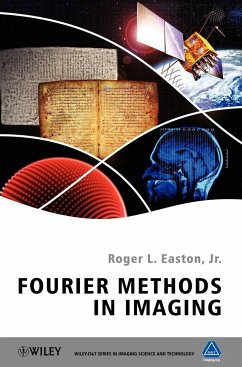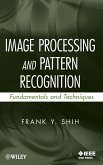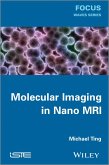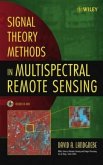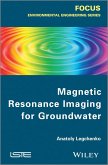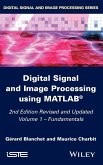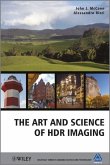Roger L Easton Jr
Fourier Methods in Imaging
Roger L Easton Jr
Fourier Methods in Imaging
- Gebundenes Buch
- Merkliste
- Auf die Merkliste
- Bewerten Bewerten
- Teilen
- Produkt teilen
- Produkterinnerung
- Produkterinnerung
Fourier Methods in Imaging introduces the mathematical tools for modeling linear imaging systems to predict the action of the system or for solving for the input. The chapters are grouped into five sections, the first introduces the imaging "tasks" (direct, inverse, and system analysis), the basic concepts of linear algebra for vectors and functions, including complex-valued vectors, and inner products of vectors and functions. The second section defines "special" functions, mathematical operations, and transformations that are useful for describing imaging systems. Among these are the Fourier…mehr
Andere Kunden interessierten sich auch für
![Image Processing and Pattern Recognition Image Processing and Pattern Recognition]() Frank Y ShihImage Processing and Pattern Recognition180,99 €
Frank Y ShihImage Processing and Pattern Recognition180,99 €![Molecular Imaging in Nano MRI Molecular Imaging in Nano MRI]() Michael TingMolecular Imaging in Nano MRI170,99 €
Michael TingMolecular Imaging in Nano MRI170,99 €![Signal Theory Methods in Multispectral Remote Sensing Signal Theory Methods in Multispectral Remote Sensing]() David A. LandgrebeSignal Theory Methods in Multispectral Remote Sensing247,99 €
David A. LandgrebeSignal Theory Methods in Multispectral Remote Sensing247,99 €![Magnetic Resonance Imaging for Groundwater Magnetic Resonance Imaging for Groundwater]() Anatoly LegtchenkoMagnetic Resonance Imaging for Groundwater166,99 €
Anatoly LegtchenkoMagnetic Resonance Imaging for Groundwater166,99 €![Digital Signal and Image Processing Using Matlab, Volume 1 Digital Signal and Image Processing Using Matlab, Volume 1]() Gérard BlanchetDigital Signal and Image Processing Using Matlab, Volume 1198,99 €
Gérard BlanchetDigital Signal and Image Processing Using Matlab, Volume 1198,99 €![Hyperspectral Data Processing Hyperspectral Data Processing]() Chein-I. ChangHyperspectral Data Processing228,99 €
Chein-I. ChangHyperspectral Data Processing228,99 €![The Art and Science of HDR Imaging The Art and Science of HDR Imaging]() John J. McCannThe Art and Science of HDR Imaging158,99 €
John J. McCannThe Art and Science of HDR Imaging158,99 €-
-
-
Fourier Methods in Imaging introduces the mathematical tools for modeling linear imaging systems to predict the action of the system or for solving for the input. The chapters are grouped into five sections, the first introduces the imaging "tasks" (direct, inverse, and system analysis), the basic concepts of linear algebra for vectors and functions, including complex-valued vectors, and inner products of vectors and functions. The second section defines "special" functions, mathematical operations, and transformations that are useful for describing imaging systems. Among these are the Fourier transforms of 1-D and 2-D function, and the Hankel and Radon transforms. This section also considers approximations of the Fourier transform. The third and fourth sections examine the discrete Fourier transform and the description of imaging systems as linear "filters", including the inverse, matched, Wiener and Wiener-Helstrom filters. The final section examines applications of linear system models to optical imaging systems, including holography. * Provides a unified mathematical description of imaging systems. * Develops a consistent mathematical formalism for characterizing imaging systems. * Helps the reader develop an intuitive grasp of the most common mathematical methods, useful for describing the action of general linear systems on signals of one or more spatial dimensions. * Offers parallel descriptions of continuous and discrete cases. * Includes many graphical and pictorial examples to illustrate the concepts. This book helps students develop an understanding of mathematical tools for describing general one- and two-dimensional linear imaging systems, and will also serve as a reference for engineers and scientists.
Hinweis: Dieser Artikel kann nur an eine deutsche Lieferadresse ausgeliefert werden.
Hinweis: Dieser Artikel kann nur an eine deutsche Lieferadresse ausgeliefert werden.
Produktdetails
- Produktdetails
- Verlag: John Wiley & Sons / Wiley
- Seitenzahl: 960
- Erscheinungstermin: 28. Juni 2010
- Englisch
- Abmessung: 250mm x 175mm x 55mm
- Gewicht: 1795g
- ISBN-13: 9780470689837
- ISBN-10: 0470689838
- Artikelnr.: 30602295
- Herstellerkennzeichnung
- Libri GmbH
- Europaallee 1
- 36244 Bad Hersfeld
- gpsr@libri.de
- Verlag: John Wiley & Sons / Wiley
- Seitenzahl: 960
- Erscheinungstermin: 28. Juni 2010
- Englisch
- Abmessung: 250mm x 175mm x 55mm
- Gewicht: 1795g
- ISBN-13: 9780470689837
- ISBN-10: 0470689838
- Artikelnr.: 30602295
- Herstellerkennzeichnung
- Libri GmbH
- Europaallee 1
- 36244 Bad Hersfeld
- gpsr@libri.de
Meg Easton is the USA Today bestselling author of contemporary romances and romantic comedies with fun, memorable, swoon-worthy characters, and settings you'll want to pack up and move to. She lives at the foot of a mountain with her name on it (or at least one letter of her name) in Utah. She loves gardening, bike riding, baking, swimming before the sun rises, and spending time with her husband and three kids. Find out more at https://megeaston.com
Series Editor's Preface.
Preface.
1 Introduction.
1.1 Signals, Operators, and Imaging Systems.
1.2 The Three Imaging Tasks.
1.3 Examples of Optical Imaging.
1.4 ImagingTasks inMedical Imaging.
2 Operators and Functions.
2.1 Classes of Imaging Operators.
2.2 Continuous and Discrete Functions.
Problems.
3 Vectors with Real-Valued Components.
3.1 Scalar Products.
3.2 Matrices.
3.3 Vector Spaces.
Problems.
4 Complex Numbers and Functions.
4.1 Arithmetic of Complex Numbers.
4.2 Graphical Representation of Complex Numbers.
4.3 Complex Functions.
4.4 Generalized Spatial Frequency - Negative Frequencies.
4.5 Argand Diagrams of Complex-Valued Functions.
Problems.
5 Complex-Valued Matrices and Systems.
5.1 Vectors with Complex-Valued Components.
5.2 Matrix Analogues of Shift-Invariant Systems.
5.3 Matrix Formulation of ImagingTasks.
5.4 Continuous Analogues of Vector Operations.
Problems.
6 1-D Special Functions.
6.1 Definitions of 1-D Special Functions.
6.2 1-D Dirac Delta Function.
6.3 1-D Complex-Valued Special Functions.
6.4 1-D Stochastic Functions-Noise.
6.5 Appendix A: Area of SINC[x] and SINC2[x].
6.6 Appendix B: Series Solutions for Bessel Functions J0[x] and J1[x].
Problems.
7 2-D Special Functions.
7.1 2-D Separable Functions.
7.2 Definitions of 2-D Special Functions.
7.3 2-D Dirac Delta Function and its Relatives.
7.4 2-D Functions with Circular Symmetry.
7.5 Complex-Valued 2-D Functions.
7.6 Special Functions of Three (orMore) Variables.
Problems.
8 Linear Operators.
8.1 Linear Operators.
8.2 Shift-Invariant.Operators.
8.3 Linear Shift-Invariant (LSI) Operators.
8.4 Calculating Convolutions.
8.5 Properties of Convolutions.
8.6 Autocorrelation.
8.7 Crosscorrelation.
8.8 2-DLSIOperations.
8.9 Crosscorrelations of 2-D Functions.
8.10 Autocorrelations of 2-D.Functions.
Problems.
9 Fourier Transforms of 1-D Functions.
9.1 Transforms of Continuous-Domain Functions.
9.2 Linear Combinations of Reference Functions.
9.3 Complex-Valued Reference Functions.
9.4 Transforms of Complex-Valued Functions.
9.5 Fourier Analysis of Dirac Delta Functions.
9.6 Inverse Fourier Transform.
9.7 Fourier Transforms of 1-D Special Functions.
9.8 Theorems of the Fourier Transform.
9.9 Appendix: Spectrum of Gaussian via Path Integral.
Problems.
10 Multidimensional Fourier Transforms.
10.1 2-D Fourier Transforms.
10.2 Spectra of Separable 2-D Functions.
10.3 Theorems of 2-D Fourier Transforms.
Problems.
11 Spectra of Circular Functions.
11.1 The Hankel Transform.
11.2 Inverse Hankel Transform.
11.3 Theorems of Hankel Transforms.
11.4 Hankel Transforms of Special Functions.
11.5 Appendix: Derivations of Equations (11.12) and (11.14).
Problems.
12 The Radon Transform.
12.1 Line-Integral Projections onto Radial Axes.
12.2 Radon Transforms of Special Functions.
12.3 Theorems of the Radon Transform.
12.4 Inverse Radon Transform.
12.5 Central-Slice Transform.
12.6 Three Transforms of Four Functions.
12.7 Fourier and Radon Transforms of Images.
Problems.
13 Approximations to Fourier Transforms.
13.1 Moment Theorem.
13.2 1-D Spectra via Method of Stationary Phase.
13.3 Central-Limit Theorem.
13.4 Width Metrics and Uncertainty Relations.
Problems.
14 Discrete Systems, Sampling, and Quantization.
14.1 Ideal Sampling.
14.2 Ideal Sampling of Special Functions.
14.3 Interpolation of Sampled Functions.
14.4 Whittaker-Shannon Sampling Theorem.
14.5 Aliasingand Interpolation.
14.6 "Prefiltering" to Prevent Aliasing.
14.7 Realistic Sampling.
14.8 Realistic Interpolation.
14.9 Quantization.
14.10 Discrete Convolution.
Problems.
15 Discrete Fourier Transforms.
15.1 Inverse of the Infinite-Support DFT.
15.2 DFT over Finite Interval.
15.3 Fourier Series Derived from Fourier Transform.
15.4 Efficient Evaluation of the Finite DFT.
15.5 Practical Considerations for DFT and FFT.
15.6 FFTs of 2-D Arrays.
15.7 Discrete Cosine Transform.
Problems.
16 Magnitude Filtering.
16.1 Classes of Filters.
16.2 Eigenfunctions of Convolution.
16.3 Power Transmission of Filters.
16.4 Lowpass Filters.
16.5 Highpass Filters.
16.6 Bandpass Filters.
16.7 Fourier Transform as a Bandpass Filter.
16.8 Bandboost and Bandstop Filters.
16.9 Wavelet Transform.
Problems.
17 Allpass (Phase) Filters.
17.1 Power-Series Expansion for Allpass Filters.
17.2 Constant-Phase Allpass Filter.
17.3 Linear-Phase Allpass Filter.
17.4 Quadratic-Phase Filter.
17.5 Allpass Filters with Higher-Order Phase.
17.6 Allpass Random-Phase Filter.
17.7 Relative Importance of Magnitude and Phase.
17.8 Imaging of Phase Objects.
17.9 Chirp Fourier Transform.
Problems.
18 Magnitude-Phase Filters.
18.1 Transfer Functions of Three Operations.
18.2 Fourier Transform of Ramp Function.
18.3 Causal Filters.
18.4 Damped Harmonic Oscillator.
18.5 Mixed Filters with Linear or Random Phase.
18.6 Mixed Filter with Quadratic Phase.
Problems.
19 Applications of Linear Filters.
19.1 Linear Filters for the Imaging Tasks.
19.2 Deconvolution- "Inverse Filtering".
19.3 Optimum Estimators for Signals in Noise.
19.4 Detection of Known Signals - Matched Filter.
19.5 Analogies of Inverse and Matched Filters.
19.6 Approximations to Reciprocal Filters.
19.7 Inverse Filtering of Shift-Variant Blur.
Problems.
20 Filtering in Discrete Systems.
20.1 Translation, Leakage, and Interpolation.
20.2 Averaging Operators- Lowpass Filters.
20.3 Differencing Operators - Highpass Filters.
20.4 Discrete Sharpening Operators.
20.5 2-DGradient.
20.6 Pattern Matching.
20.7 Approximate Discrete Reciprocal Filters.
Problems.
21 Optical Imaging in Monochromatic Light.
21.1 Imaging Systems Based on Ray Optics Model.
21.2 Mathematical Model of Light Propagation.
21.3 Fraunhofer Diffraction.
21.4 Imaging System based on Fraunhofer Diffraction.
21.5 Transmissive Optical Elements.
21.6 Monochromatic Optical Systems.
21.7 Shift-Variant Imaging Systems.
Problems.
22 Incoherent Optical Imaging Systems.
22.1 Coherence.
22.2 Polychromatic Source - Temporal Coherence.
22.3 Imaging in Incoherent Light.
22.4 System Function in Incoherent Light.
Problems.
23 Holography.
23.1 Fraunhofer Holography.
23.2 Holography in Fresnel Diffraction Region.
23.3 Computer-Generated Holography.
23.4 Matched Filtering with Cell-Type CGH.
23.5 Synthetic-Aperture Radar (SAR).
Problems.
References.
Index.
Preface.
1 Introduction.
1.1 Signals, Operators, and Imaging Systems.
1.2 The Three Imaging Tasks.
1.3 Examples of Optical Imaging.
1.4 ImagingTasks inMedical Imaging.
2 Operators and Functions.
2.1 Classes of Imaging Operators.
2.2 Continuous and Discrete Functions.
Problems.
3 Vectors with Real-Valued Components.
3.1 Scalar Products.
3.2 Matrices.
3.3 Vector Spaces.
Problems.
4 Complex Numbers and Functions.
4.1 Arithmetic of Complex Numbers.
4.2 Graphical Representation of Complex Numbers.
4.3 Complex Functions.
4.4 Generalized Spatial Frequency - Negative Frequencies.
4.5 Argand Diagrams of Complex-Valued Functions.
Problems.
5 Complex-Valued Matrices and Systems.
5.1 Vectors with Complex-Valued Components.
5.2 Matrix Analogues of Shift-Invariant Systems.
5.3 Matrix Formulation of ImagingTasks.
5.4 Continuous Analogues of Vector Operations.
Problems.
6 1-D Special Functions.
6.1 Definitions of 1-D Special Functions.
6.2 1-D Dirac Delta Function.
6.3 1-D Complex-Valued Special Functions.
6.4 1-D Stochastic Functions-Noise.
6.5 Appendix A: Area of SINC[x] and SINC2[x].
6.6 Appendix B: Series Solutions for Bessel Functions J0[x] and J1[x].
Problems.
7 2-D Special Functions.
7.1 2-D Separable Functions.
7.2 Definitions of 2-D Special Functions.
7.3 2-D Dirac Delta Function and its Relatives.
7.4 2-D Functions with Circular Symmetry.
7.5 Complex-Valued 2-D Functions.
7.6 Special Functions of Three (orMore) Variables.
Problems.
8 Linear Operators.
8.1 Linear Operators.
8.2 Shift-Invariant.Operators.
8.3 Linear Shift-Invariant (LSI) Operators.
8.4 Calculating Convolutions.
8.5 Properties of Convolutions.
8.6 Autocorrelation.
8.7 Crosscorrelation.
8.8 2-DLSIOperations.
8.9 Crosscorrelations of 2-D Functions.
8.10 Autocorrelations of 2-D.Functions.
Problems.
9 Fourier Transforms of 1-D Functions.
9.1 Transforms of Continuous-Domain Functions.
9.2 Linear Combinations of Reference Functions.
9.3 Complex-Valued Reference Functions.
9.4 Transforms of Complex-Valued Functions.
9.5 Fourier Analysis of Dirac Delta Functions.
9.6 Inverse Fourier Transform.
9.7 Fourier Transforms of 1-D Special Functions.
9.8 Theorems of the Fourier Transform.
9.9 Appendix: Spectrum of Gaussian via Path Integral.
Problems.
10 Multidimensional Fourier Transforms.
10.1 2-D Fourier Transforms.
10.2 Spectra of Separable 2-D Functions.
10.3 Theorems of 2-D Fourier Transforms.
Problems.
11 Spectra of Circular Functions.
11.1 The Hankel Transform.
11.2 Inverse Hankel Transform.
11.3 Theorems of Hankel Transforms.
11.4 Hankel Transforms of Special Functions.
11.5 Appendix: Derivations of Equations (11.12) and (11.14).
Problems.
12 The Radon Transform.
12.1 Line-Integral Projections onto Radial Axes.
12.2 Radon Transforms of Special Functions.
12.3 Theorems of the Radon Transform.
12.4 Inverse Radon Transform.
12.5 Central-Slice Transform.
12.6 Three Transforms of Four Functions.
12.7 Fourier and Radon Transforms of Images.
Problems.
13 Approximations to Fourier Transforms.
13.1 Moment Theorem.
13.2 1-D Spectra via Method of Stationary Phase.
13.3 Central-Limit Theorem.
13.4 Width Metrics and Uncertainty Relations.
Problems.
14 Discrete Systems, Sampling, and Quantization.
14.1 Ideal Sampling.
14.2 Ideal Sampling of Special Functions.
14.3 Interpolation of Sampled Functions.
14.4 Whittaker-Shannon Sampling Theorem.
14.5 Aliasingand Interpolation.
14.6 "Prefiltering" to Prevent Aliasing.
14.7 Realistic Sampling.
14.8 Realistic Interpolation.
14.9 Quantization.
14.10 Discrete Convolution.
Problems.
15 Discrete Fourier Transforms.
15.1 Inverse of the Infinite-Support DFT.
15.2 DFT over Finite Interval.
15.3 Fourier Series Derived from Fourier Transform.
15.4 Efficient Evaluation of the Finite DFT.
15.5 Practical Considerations for DFT and FFT.
15.6 FFTs of 2-D Arrays.
15.7 Discrete Cosine Transform.
Problems.
16 Magnitude Filtering.
16.1 Classes of Filters.
16.2 Eigenfunctions of Convolution.
16.3 Power Transmission of Filters.
16.4 Lowpass Filters.
16.5 Highpass Filters.
16.6 Bandpass Filters.
16.7 Fourier Transform as a Bandpass Filter.
16.8 Bandboost and Bandstop Filters.
16.9 Wavelet Transform.
Problems.
17 Allpass (Phase) Filters.
17.1 Power-Series Expansion for Allpass Filters.
17.2 Constant-Phase Allpass Filter.
17.3 Linear-Phase Allpass Filter.
17.4 Quadratic-Phase Filter.
17.5 Allpass Filters with Higher-Order Phase.
17.6 Allpass Random-Phase Filter.
17.7 Relative Importance of Magnitude and Phase.
17.8 Imaging of Phase Objects.
17.9 Chirp Fourier Transform.
Problems.
18 Magnitude-Phase Filters.
18.1 Transfer Functions of Three Operations.
18.2 Fourier Transform of Ramp Function.
18.3 Causal Filters.
18.4 Damped Harmonic Oscillator.
18.5 Mixed Filters with Linear or Random Phase.
18.6 Mixed Filter with Quadratic Phase.
Problems.
19 Applications of Linear Filters.
19.1 Linear Filters for the Imaging Tasks.
19.2 Deconvolution- "Inverse Filtering".
19.3 Optimum Estimators for Signals in Noise.
19.4 Detection of Known Signals - Matched Filter.
19.5 Analogies of Inverse and Matched Filters.
19.6 Approximations to Reciprocal Filters.
19.7 Inverse Filtering of Shift-Variant Blur.
Problems.
20 Filtering in Discrete Systems.
20.1 Translation, Leakage, and Interpolation.
20.2 Averaging Operators- Lowpass Filters.
20.3 Differencing Operators - Highpass Filters.
20.4 Discrete Sharpening Operators.
20.5 2-DGradient.
20.6 Pattern Matching.
20.7 Approximate Discrete Reciprocal Filters.
Problems.
21 Optical Imaging in Monochromatic Light.
21.1 Imaging Systems Based on Ray Optics Model.
21.2 Mathematical Model of Light Propagation.
21.3 Fraunhofer Diffraction.
21.4 Imaging System based on Fraunhofer Diffraction.
21.5 Transmissive Optical Elements.
21.6 Monochromatic Optical Systems.
21.7 Shift-Variant Imaging Systems.
Problems.
22 Incoherent Optical Imaging Systems.
22.1 Coherence.
22.2 Polychromatic Source - Temporal Coherence.
22.3 Imaging in Incoherent Light.
22.4 System Function in Incoherent Light.
Problems.
23 Holography.
23.1 Fraunhofer Holography.
23.2 Holography in Fresnel Diffraction Region.
23.3 Computer-Generated Holography.
23.4 Matched Filtering with Cell-Type CGH.
23.5 Synthetic-Aperture Radar (SAR).
Problems.
References.
Index.
Series Editor's Preface.
Preface.
1 Introduction.
1.1 Signals, Operators, and Imaging Systems.
1.2 The Three Imaging Tasks.
1.3 Examples of Optical Imaging.
1.4 ImagingTasks inMedical Imaging.
2 Operators and Functions.
2.1 Classes of Imaging Operators.
2.2 Continuous and Discrete Functions.
Problems.
3 Vectors with Real-Valued Components.
3.1 Scalar Products.
3.2 Matrices.
3.3 Vector Spaces.
Problems.
4 Complex Numbers and Functions.
4.1 Arithmetic of Complex Numbers.
4.2 Graphical Representation of Complex Numbers.
4.3 Complex Functions.
4.4 Generalized Spatial Frequency - Negative Frequencies.
4.5 Argand Diagrams of Complex-Valued Functions.
Problems.
5 Complex-Valued Matrices and Systems.
5.1 Vectors with Complex-Valued Components.
5.2 Matrix Analogues of Shift-Invariant Systems.
5.3 Matrix Formulation of ImagingTasks.
5.4 Continuous Analogues of Vector Operations.
Problems.
6 1-D Special Functions.
6.1 Definitions of 1-D Special Functions.
6.2 1-D Dirac Delta Function.
6.3 1-D Complex-Valued Special Functions.
6.4 1-D Stochastic Functions-Noise.
6.5 Appendix A: Area of SINC[x] and SINC2[x].
6.6 Appendix B: Series Solutions for Bessel Functions J0[x] and J1[x].
Problems.
7 2-D Special Functions.
7.1 2-D Separable Functions.
7.2 Definitions of 2-D Special Functions.
7.3 2-D Dirac Delta Function and its Relatives.
7.4 2-D Functions with Circular Symmetry.
7.5 Complex-Valued 2-D Functions.
7.6 Special Functions of Three (orMore) Variables.
Problems.
8 Linear Operators.
8.1 Linear Operators.
8.2 Shift-Invariant.Operators.
8.3 Linear Shift-Invariant (LSI) Operators.
8.4 Calculating Convolutions.
8.5 Properties of Convolutions.
8.6 Autocorrelation.
8.7 Crosscorrelation.
8.8 2-DLSIOperations.
8.9 Crosscorrelations of 2-D Functions.
8.10 Autocorrelations of 2-D.Functions.
Problems.
9 Fourier Transforms of 1-D Functions.
9.1 Transforms of Continuous-Domain Functions.
9.2 Linear Combinations of Reference Functions.
9.3 Complex-Valued Reference Functions.
9.4 Transforms of Complex-Valued Functions.
9.5 Fourier Analysis of Dirac Delta Functions.
9.6 Inverse Fourier Transform.
9.7 Fourier Transforms of 1-D Special Functions.
9.8 Theorems of the Fourier Transform.
9.9 Appendix: Spectrum of Gaussian via Path Integral.
Problems.
10 Multidimensional Fourier Transforms.
10.1 2-D Fourier Transforms.
10.2 Spectra of Separable 2-D Functions.
10.3 Theorems of 2-D Fourier Transforms.
Problems.
11 Spectra of Circular Functions.
11.1 The Hankel Transform.
11.2 Inverse Hankel Transform.
11.3 Theorems of Hankel Transforms.
11.4 Hankel Transforms of Special Functions.
11.5 Appendix: Derivations of Equations (11.12) and (11.14).
Problems.
12 The Radon Transform.
12.1 Line-Integral Projections onto Radial Axes.
12.2 Radon Transforms of Special Functions.
12.3 Theorems of the Radon Transform.
12.4 Inverse Radon Transform.
12.5 Central-Slice Transform.
12.6 Three Transforms of Four Functions.
12.7 Fourier and Radon Transforms of Images.
Problems.
13 Approximations to Fourier Transforms.
13.1 Moment Theorem.
13.2 1-D Spectra via Method of Stationary Phase.
13.3 Central-Limit Theorem.
13.4 Width Metrics and Uncertainty Relations.
Problems.
14 Discrete Systems, Sampling, and Quantization.
14.1 Ideal Sampling.
14.2 Ideal Sampling of Special Functions.
14.3 Interpolation of Sampled Functions.
14.4 Whittaker-Shannon Sampling Theorem.
14.5 Aliasingand Interpolation.
14.6 "Prefiltering" to Prevent Aliasing.
14.7 Realistic Sampling.
14.8 Realistic Interpolation.
14.9 Quantization.
14.10 Discrete Convolution.
Problems.
15 Discrete Fourier Transforms.
15.1 Inverse of the Infinite-Support DFT.
15.2 DFT over Finite Interval.
15.3 Fourier Series Derived from Fourier Transform.
15.4 Efficient Evaluation of the Finite DFT.
15.5 Practical Considerations for DFT and FFT.
15.6 FFTs of 2-D Arrays.
15.7 Discrete Cosine Transform.
Problems.
16 Magnitude Filtering.
16.1 Classes of Filters.
16.2 Eigenfunctions of Convolution.
16.3 Power Transmission of Filters.
16.4 Lowpass Filters.
16.5 Highpass Filters.
16.6 Bandpass Filters.
16.7 Fourier Transform as a Bandpass Filter.
16.8 Bandboost and Bandstop Filters.
16.9 Wavelet Transform.
Problems.
17 Allpass (Phase) Filters.
17.1 Power-Series Expansion for Allpass Filters.
17.2 Constant-Phase Allpass Filter.
17.3 Linear-Phase Allpass Filter.
17.4 Quadratic-Phase Filter.
17.5 Allpass Filters with Higher-Order Phase.
17.6 Allpass Random-Phase Filter.
17.7 Relative Importance of Magnitude and Phase.
17.8 Imaging of Phase Objects.
17.9 Chirp Fourier Transform.
Problems.
18 Magnitude-Phase Filters.
18.1 Transfer Functions of Three Operations.
18.2 Fourier Transform of Ramp Function.
18.3 Causal Filters.
18.4 Damped Harmonic Oscillator.
18.5 Mixed Filters with Linear or Random Phase.
18.6 Mixed Filter with Quadratic Phase.
Problems.
19 Applications of Linear Filters.
19.1 Linear Filters for the Imaging Tasks.
19.2 Deconvolution- "Inverse Filtering".
19.3 Optimum Estimators for Signals in Noise.
19.4 Detection of Known Signals - Matched Filter.
19.5 Analogies of Inverse and Matched Filters.
19.6 Approximations to Reciprocal Filters.
19.7 Inverse Filtering of Shift-Variant Blur.
Problems.
20 Filtering in Discrete Systems.
20.1 Translation, Leakage, and Interpolation.
20.2 Averaging Operators- Lowpass Filters.
20.3 Differencing Operators - Highpass Filters.
20.4 Discrete Sharpening Operators.
20.5 2-DGradient.
20.6 Pattern Matching.
20.7 Approximate Discrete Reciprocal Filters.
Problems.
21 Optical Imaging in Monochromatic Light.
21.1 Imaging Systems Based on Ray Optics Model.
21.2 Mathematical Model of Light Propagation.
21.3 Fraunhofer Diffraction.
21.4 Imaging System based on Fraunhofer Diffraction.
21.5 Transmissive Optical Elements.
21.6 Monochromatic Optical Systems.
21.7 Shift-Variant Imaging Systems.
Problems.
22 Incoherent Optical Imaging Systems.
22.1 Coherence.
22.2 Polychromatic Source - Temporal Coherence.
22.3 Imaging in Incoherent Light.
22.4 System Function in Incoherent Light.
Problems.
23 Holography.
23.1 Fraunhofer Holography.
23.2 Holography in Fresnel Diffraction Region.
23.3 Computer-Generated Holography.
23.4 Matched Filtering with Cell-Type CGH.
23.5 Synthetic-Aperture Radar (SAR).
Problems.
References.
Index.
Preface.
1 Introduction.
1.1 Signals, Operators, and Imaging Systems.
1.2 The Three Imaging Tasks.
1.3 Examples of Optical Imaging.
1.4 ImagingTasks inMedical Imaging.
2 Operators and Functions.
2.1 Classes of Imaging Operators.
2.2 Continuous and Discrete Functions.
Problems.
3 Vectors with Real-Valued Components.
3.1 Scalar Products.
3.2 Matrices.
3.3 Vector Spaces.
Problems.
4 Complex Numbers and Functions.
4.1 Arithmetic of Complex Numbers.
4.2 Graphical Representation of Complex Numbers.
4.3 Complex Functions.
4.4 Generalized Spatial Frequency - Negative Frequencies.
4.5 Argand Diagrams of Complex-Valued Functions.
Problems.
5 Complex-Valued Matrices and Systems.
5.1 Vectors with Complex-Valued Components.
5.2 Matrix Analogues of Shift-Invariant Systems.
5.3 Matrix Formulation of ImagingTasks.
5.4 Continuous Analogues of Vector Operations.
Problems.
6 1-D Special Functions.
6.1 Definitions of 1-D Special Functions.
6.2 1-D Dirac Delta Function.
6.3 1-D Complex-Valued Special Functions.
6.4 1-D Stochastic Functions-Noise.
6.5 Appendix A: Area of SINC[x] and SINC2[x].
6.6 Appendix B: Series Solutions for Bessel Functions J0[x] and J1[x].
Problems.
7 2-D Special Functions.
7.1 2-D Separable Functions.
7.2 Definitions of 2-D Special Functions.
7.3 2-D Dirac Delta Function and its Relatives.
7.4 2-D Functions with Circular Symmetry.
7.5 Complex-Valued 2-D Functions.
7.6 Special Functions of Three (orMore) Variables.
Problems.
8 Linear Operators.
8.1 Linear Operators.
8.2 Shift-Invariant.Operators.
8.3 Linear Shift-Invariant (LSI) Operators.
8.4 Calculating Convolutions.
8.5 Properties of Convolutions.
8.6 Autocorrelation.
8.7 Crosscorrelation.
8.8 2-DLSIOperations.
8.9 Crosscorrelations of 2-D Functions.
8.10 Autocorrelations of 2-D.Functions.
Problems.
9 Fourier Transforms of 1-D Functions.
9.1 Transforms of Continuous-Domain Functions.
9.2 Linear Combinations of Reference Functions.
9.3 Complex-Valued Reference Functions.
9.4 Transforms of Complex-Valued Functions.
9.5 Fourier Analysis of Dirac Delta Functions.
9.6 Inverse Fourier Transform.
9.7 Fourier Transforms of 1-D Special Functions.
9.8 Theorems of the Fourier Transform.
9.9 Appendix: Spectrum of Gaussian via Path Integral.
Problems.
10 Multidimensional Fourier Transforms.
10.1 2-D Fourier Transforms.
10.2 Spectra of Separable 2-D Functions.
10.3 Theorems of 2-D Fourier Transforms.
Problems.
11 Spectra of Circular Functions.
11.1 The Hankel Transform.
11.2 Inverse Hankel Transform.
11.3 Theorems of Hankel Transforms.
11.4 Hankel Transforms of Special Functions.
11.5 Appendix: Derivations of Equations (11.12) and (11.14).
Problems.
12 The Radon Transform.
12.1 Line-Integral Projections onto Radial Axes.
12.2 Radon Transforms of Special Functions.
12.3 Theorems of the Radon Transform.
12.4 Inverse Radon Transform.
12.5 Central-Slice Transform.
12.6 Three Transforms of Four Functions.
12.7 Fourier and Radon Transforms of Images.
Problems.
13 Approximations to Fourier Transforms.
13.1 Moment Theorem.
13.2 1-D Spectra via Method of Stationary Phase.
13.3 Central-Limit Theorem.
13.4 Width Metrics and Uncertainty Relations.
Problems.
14 Discrete Systems, Sampling, and Quantization.
14.1 Ideal Sampling.
14.2 Ideal Sampling of Special Functions.
14.3 Interpolation of Sampled Functions.
14.4 Whittaker-Shannon Sampling Theorem.
14.5 Aliasingand Interpolation.
14.6 "Prefiltering" to Prevent Aliasing.
14.7 Realistic Sampling.
14.8 Realistic Interpolation.
14.9 Quantization.
14.10 Discrete Convolution.
Problems.
15 Discrete Fourier Transforms.
15.1 Inverse of the Infinite-Support DFT.
15.2 DFT over Finite Interval.
15.3 Fourier Series Derived from Fourier Transform.
15.4 Efficient Evaluation of the Finite DFT.
15.5 Practical Considerations for DFT and FFT.
15.6 FFTs of 2-D Arrays.
15.7 Discrete Cosine Transform.
Problems.
16 Magnitude Filtering.
16.1 Classes of Filters.
16.2 Eigenfunctions of Convolution.
16.3 Power Transmission of Filters.
16.4 Lowpass Filters.
16.5 Highpass Filters.
16.6 Bandpass Filters.
16.7 Fourier Transform as a Bandpass Filter.
16.8 Bandboost and Bandstop Filters.
16.9 Wavelet Transform.
Problems.
17 Allpass (Phase) Filters.
17.1 Power-Series Expansion for Allpass Filters.
17.2 Constant-Phase Allpass Filter.
17.3 Linear-Phase Allpass Filter.
17.4 Quadratic-Phase Filter.
17.5 Allpass Filters with Higher-Order Phase.
17.6 Allpass Random-Phase Filter.
17.7 Relative Importance of Magnitude and Phase.
17.8 Imaging of Phase Objects.
17.9 Chirp Fourier Transform.
Problems.
18 Magnitude-Phase Filters.
18.1 Transfer Functions of Three Operations.
18.2 Fourier Transform of Ramp Function.
18.3 Causal Filters.
18.4 Damped Harmonic Oscillator.
18.5 Mixed Filters with Linear or Random Phase.
18.6 Mixed Filter with Quadratic Phase.
Problems.
19 Applications of Linear Filters.
19.1 Linear Filters for the Imaging Tasks.
19.2 Deconvolution- "Inverse Filtering".
19.3 Optimum Estimators for Signals in Noise.
19.4 Detection of Known Signals - Matched Filter.
19.5 Analogies of Inverse and Matched Filters.
19.6 Approximations to Reciprocal Filters.
19.7 Inverse Filtering of Shift-Variant Blur.
Problems.
20 Filtering in Discrete Systems.
20.1 Translation, Leakage, and Interpolation.
20.2 Averaging Operators- Lowpass Filters.
20.3 Differencing Operators - Highpass Filters.
20.4 Discrete Sharpening Operators.
20.5 2-DGradient.
20.6 Pattern Matching.
20.7 Approximate Discrete Reciprocal Filters.
Problems.
21 Optical Imaging in Monochromatic Light.
21.1 Imaging Systems Based on Ray Optics Model.
21.2 Mathematical Model of Light Propagation.
21.3 Fraunhofer Diffraction.
21.4 Imaging System based on Fraunhofer Diffraction.
21.5 Transmissive Optical Elements.
21.6 Monochromatic Optical Systems.
21.7 Shift-Variant Imaging Systems.
Problems.
22 Incoherent Optical Imaging Systems.
22.1 Coherence.
22.2 Polychromatic Source - Temporal Coherence.
22.3 Imaging in Incoherent Light.
22.4 System Function in Incoherent Light.
Problems.
23 Holography.
23.1 Fraunhofer Holography.
23.2 Holography in Fresnel Diffraction Region.
23.3 Computer-Generated Holography.
23.4 Matched Filtering with Cell-Type CGH.
23.5 Synthetic-Aperture Radar (SAR).
Problems.
References.
Index.

